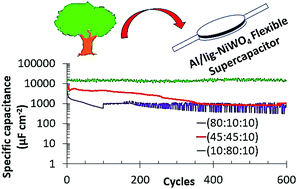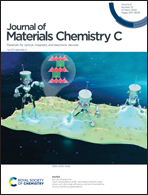NiWO4 nanoparticle decorated lignin as electrodes for asymmetric flexible supercapacitors
Abstract
In order to meet our increasing energy demand, a flexible, lightweight, and highly organized energy management strategy is needed for flexible supercapacitors. With that perspective, an anode electrode has been designed by depositing NiWO4 nanoparticles on lignin (lig) on an aluminum substrate. A supercapacitor was assembled by using Al/lig–NiWO4 as the anode, Al/AC (activated carbon) as the cathode, and PVA/H3PO4 gel as the electrolyte. Superior electrochemical performance was achieved even after 2000 cycles of charge and discharge study. The maximum specific capacitance at 0.13 A g−1 is 17.01 mF cm−2, which is more than 42 times that reported. The capacitance retention is maintained at about 97% after 1000 cycles, and at 84% after 2000 cycles. The maximum energy and power densities are 2 W h cm−2 and 100 W cm−2, respectively. A series of the composition of lig : NiWO4 : PVDF was tested to optimize the electrochemical performance. It was found that the best performance was achieved for the ratio (10 : 80 : 10) that had predominantly NiWO4 nanoparticles. The remarkable electrochemical performance of this new class of capacitors makes them useful for a wide variety of electronics.



 Please wait while we load your content...
Please wait while we load your content...